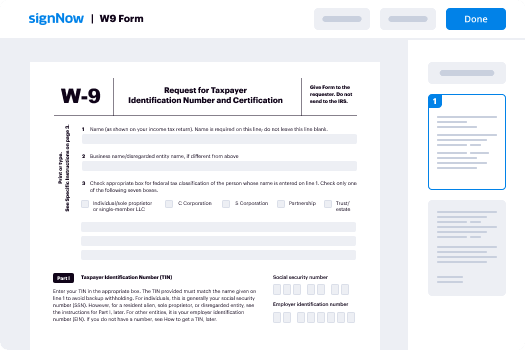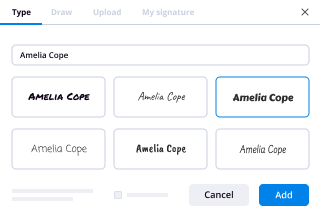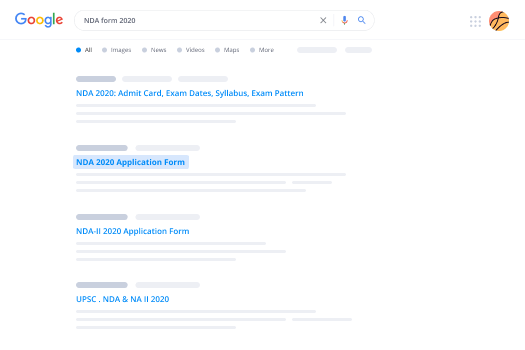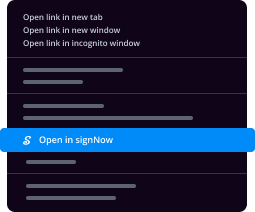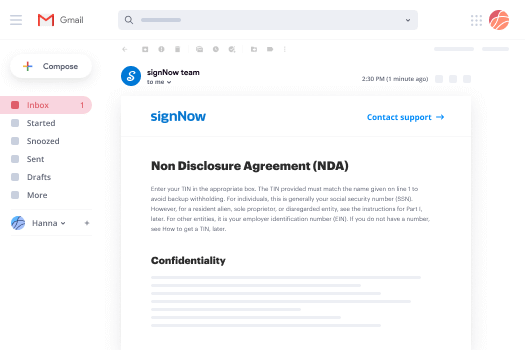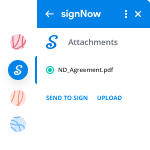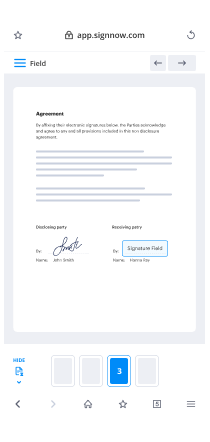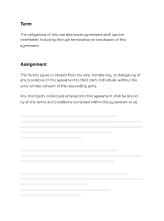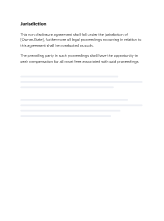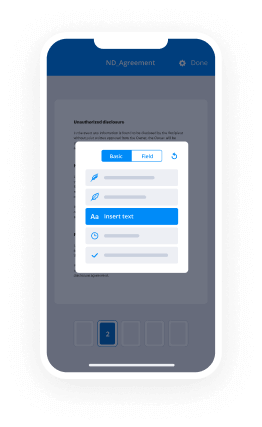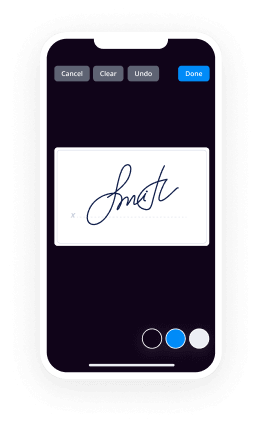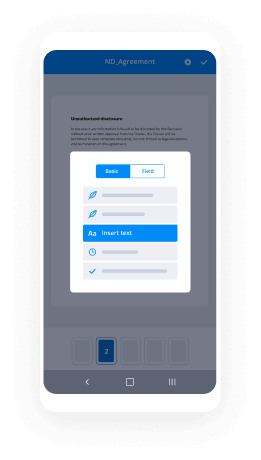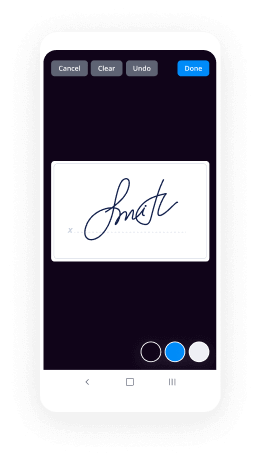Explora La Firma En Línea: ¿qué Es Un Bloque De Firma?
- Rápido para iniciar
- Fácil de usar
- Soporte 24/7
Las empresas con visión de futuro de todo el mundo confían en SignNow






Guía rápida: ¿qué es un bloque de firma?
airSlate SignNow eSignature es una solución robusta para simplificar la recopilación de datos, la negociación de contratos, la interacción externa e interna, y agilizar los procedimientos de toma de decisiones. Firmar documentos en formato electrónico es fácil para equipos, socios y clientes, y ayuda a su organización a reducir el desperdicio de papel y el gasto innecesario del presupuesto.
Siga los pasos a continuación y descubra qué es un bloque de firma:
- Abra su navegador web y visite signnow.com.
- Regístrese para una prueba gratuita o inicie sesión usando su correo electrónico o credenciales de Google/Facebook.
- Haga clic en Avatar de Usuario -> Mi Cuenta en la esquina superior derecha de la página.
- Personalice su Perfil de Usuario con sus datos personales y ajuste configuraciones.
- Haga y gestione su(s) Firma(s) Predeterminada(s).
- Regrese a la página del panel de control.
- Desplace el cursor sobre el botón Subir y Crear y elija la opción adecuada.
- Haga clic en la tecla Preparar y Enviar junto al nombre del documento.
- Ingrese la dirección de correo electrónico y el nombre de todos los firmantes en la ventana emergente que se abre.
- Utilice la opción Comenzar a agregar campos para comenzar a modificar el archivo y firmarlo usted mismo.
- Haga clic en GUARDAR Y INVITAR cuando haya terminado.
- Continúe configurando su flujo de trabajo de eSignature utilizando más funciones.
¿Qué es un bloque de firma? es una excelente pregunta y airSlate SignNow es la respuesta. Obtenga la función que usted y su equipo están buscando, deleitando a sus clientes y socios con una mejor manera de hacer negocios. ¡Firme su primer contrato hoy!
Cómo funciona
Califica tu experiencia
What is the signature block
A signature block is a designated area within a document where individuals can provide their signatures, affirming their agreement or approval of the content. Typically located at the end of contracts, agreements, or forms, this block may include fields for the signer's name, title, date, and additional information relevant to the signing party. In the context of electronic documents, a signature block allows for the use of eSignatures, enabling users to sign documents digitally, streamlining workflows and enhancing efficiency.
How to use the signature block
To effectively use a signature block in an electronic document, start by ensuring that all required fields are present. Users can fill out the document online, entering relevant information such as their name and title in the appropriate fields. Once completed, the document can be sent for signature through the airSlate SignNow platform. Recipients will receive a notification to review and sign the document electronically, making the process quick and secure.
Steps to complete the signature block
Completing a signature block electronically involves several straightforward steps:
- Open the document in airSlate SignNow and navigate to the signature block.
- Fill in your name and any other required information, such as title and date.
- Review the document to ensure all information is accurate.
- Click on the designated area to apply your eSignature.
- Submit the document for finalization or share it with other parties as needed.
Legal use of the signature block
The signature block holds significant legal weight, as it indicates the signer's consent to the terms outlined in the document. In the United States, electronic signatures are legally recognized under the Electronic Signatures in Global and National Commerce (ESIGN) Act and the Uniform Electronic Transactions Act (UETA). This means that a properly executed eSignature within a signature block is as binding as a handwritten signature, provided that both parties agree to use electronic means for signing.
Key elements of the signature block
A well-structured signature block typically includes the following key elements:
- Signer's name: The full name of the individual signing the document.
- Title: The position or role of the signer within their organization, if applicable.
- Date: The date on which the document is signed.
- Signature field: The area where the eSignature is applied.
- Additional notes: Any pertinent information that may be required by the document's context.
Examples of using the signature block
Signature blocks are commonly used in various documents, including:
- Contracts: Formal agreements between parties that require mutual consent.
- Legal documents: Such as wills, powers of attorney, and real estate transactions.
- Business agreements: Including partnership agreements and non-disclosure agreements.
- HR documents: Such as employment contracts and policy acknowledgments.
In each case, the signature block serves to formalize the agreement and ensure that all parties are in alignment with the document's terms.
¡Obtenga ahora firmas vinculantes desde el punto de vista jurídico!
-
Mejor ROI. Nuestros clientes logran un promedio de 7x ROI en los primeros seis meses.
-
Se adapta a sus casos de uso. De las PYMES al mercado medio, airSlate SignNow ofrece resultados para empresas de todos los tamaños.
-
Interfaz de usuario intuitiva y API. Firma y envía documentos desde tus aplicaciones en minutos.
Firma en línea FAQs
-
What is a signature block?
A signature block is a designated area in a document where a signer can provide their signature. Understanding what a signature block is essential for ensuring that your documents are properly executed and legally binding. -
How does airSlate SignNow utilize a signature block?
airSlate SignNow allows users to create and customize signature blocks within their documents. This feature ensures that signers can easily find where to sign, streamlining the eSigning process and enhancing user experience. -
What are the benefits of using a signature block in documents?
Using a signature block helps clarify where signatures are required, reducing confusion for signers. It also enhances the professionalism of your documents, making them look more organized and legally compliant. -
Can I customize the signature block in airSlate SignNow?
Yes, airSlate SignNow offers customization options for signature blocks. You can adjust the size, position, and appearance to fit your document's design and ensure that it meets your specific needs. -
Is there a cost associated with using signature blocks in airSlate SignNow?
airSlate SignNow provides a cost-effective solution for eSigning documents, including the use of signature blocks. Pricing plans vary, but they are designed to accommodate businesses of all sizes, ensuring you get great value. -
What integrations does airSlate SignNow offer for signature blocks?
airSlate SignNow integrates seamlessly with various applications, allowing you to use signature blocks across different platforms. This enhances workflow efficiency and ensures that your documents are easily accessible and manageable. -
How secure are the signature blocks created with airSlate SignNow?
Signature blocks created with airSlate SignNow are highly secure, utilizing advanced encryption methods. This ensures that your documents and signatures are protected, providing peace of mind for both senders and signers.




















